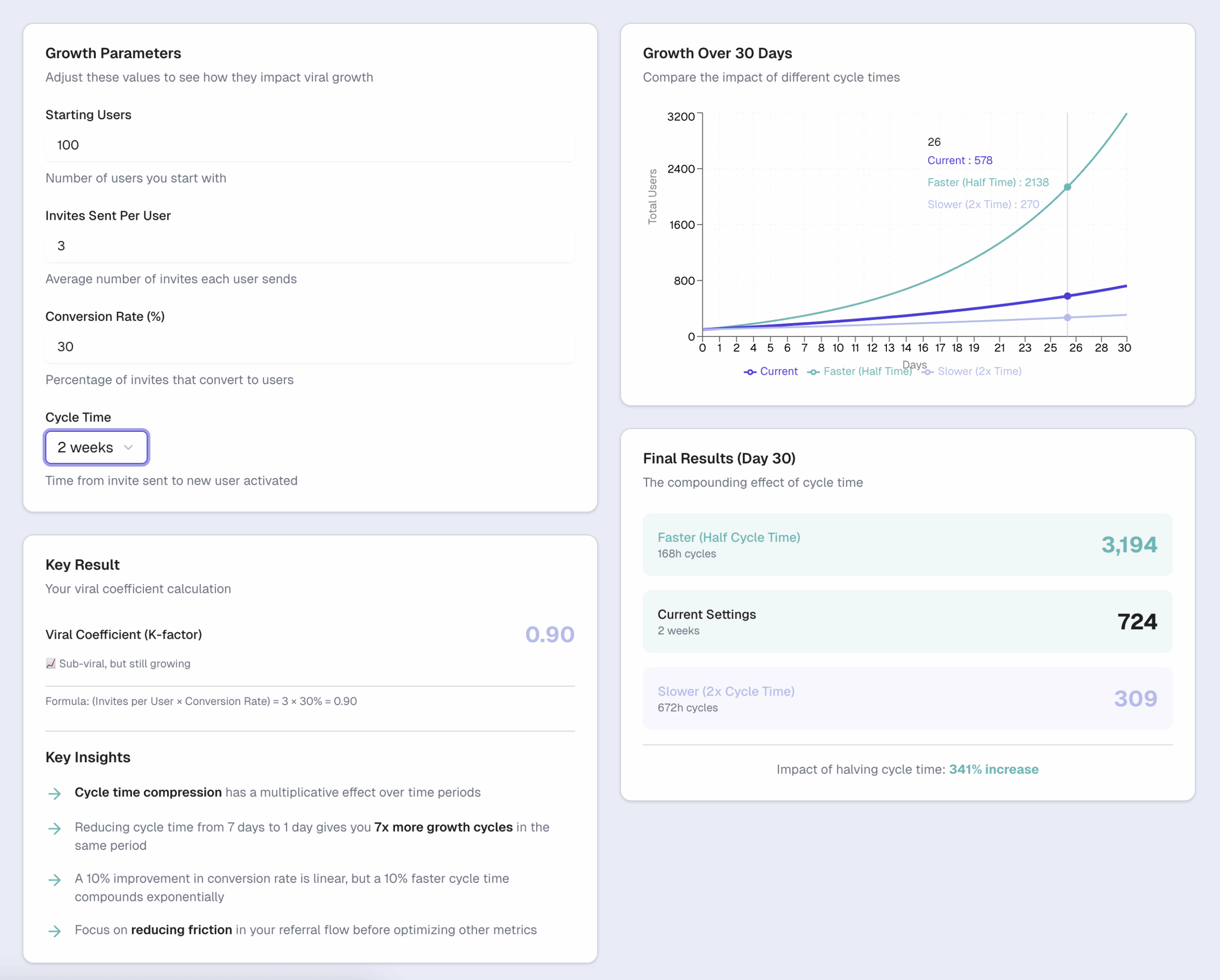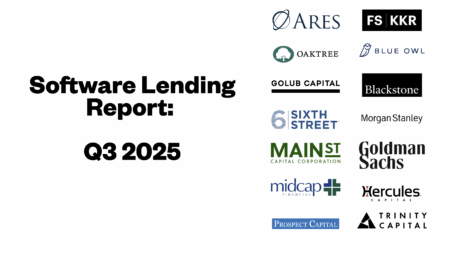
Every software founder wants to go viral in 2025. Very few understand the math and psychology behind making it happen.
Going Viral means 1 user invites 5 more users where at least 2 accept the invite. If you can turn 1 user into 2 users every day, you hit 1m users in just 20 days.
If 5% of new users convert to a $10/mo paying customers, you just build a $500k/mo SaaS in 20 days.
Thats the power of virality.
Most growth teams do not focus on engineering virality. They let it happen “by accident”. To engineer virality, you have to consider 2 things:
K Factor:
- Invite rate (#): How many new users does the first user invite?
- Conversion (C%): What % of the invitations get accepted?
…. and how fast you can get users to send invites that get accepted:
- Speed (t/ct): How fast do the invitations get accepted?
Most people focus on Invite Rate but that would be wrong. I’ll show you why in a minute.
Start by picking which form of Virality best matches your product.
7 Ways to Make Your Software Go Viral
- Default Virality: Make sharing a natural part of the user experience. Loom’s early growth engineer explained how they encouraged users to invite coworkers to unlock new features, leading to a 1.8x increase in weekly active users and a 2.6x increase in signups. The most famous example are document signing apps that require at least 2 people to sign. YouCanBook.Me’s founder Bridget Harris explained that their viral loop is powered by the 1.3 million bookings made each month, as each booking introduces the tool to a new potential user, driving over 150,000 new accounts per year for free.
- Embeddable Virality: Users create something on your platform and then embed it via iframe, or host it via a subdomain on their own website. Tally Forms has gone from $0 to $4m in revenue using this tactic.
- Paid Virality: Reward your existing users for bringing new users to the platform. Sean Ellis shared how Dropbox’s double-sided referral program, which gave free storage to both the referrer and the new user, was a key driver in their explosive growth.
- Powered By Virality: Users build something with your product, you attach your logo, or a badge, to the thing the user created. Clickfunnels bootstrapped from $0 to $200m in revenue largely based on “powered by Clickfunnels” badges in the bottom of landing pages its users created.
- Collaboration Virality: Your product can be used by 1 user but it gets more valuable when that user invites their team. Video editors who invite their whole team to Frame.io are an example of this. Miro or Canva are other examples.
- Social Virality: You understand the algorithms and consistently create content or product experiences that go viral. This is very difficult to do consistently.
- Word of Mouth Virality: Create a space for users to connect, learn from each other, and become advocates. OpenView’s Kyle Poyar highlighted how Webflow built a powerful community for freelance designers, which became a major source of long-tail SEO content and new user acquisition.
The Big Question: Can you Get Users to Send Invites Faster?
The model below assumes you start with 100 users and get each user to send 3 invites. Of those 3 invites, 30% accept.
The 3 lines on the right show the power of making this viral loop work faster. At the end of 30 days, if the invite and accept loop happens one time per 2 weeks, you end up with 724 users.
If you can compress that to 1 week, you more than 4x your users to 3,194:

Click here to try the calculator.
Lets take a look at examples of each kind of virality with real case studies.
Default Virality
- Loom’s early growth team built a feature that unlocked advanced video editing capabilities if users invited their coworkers, which led to an explosion of users within organizations and contributed to their near billion-dollar exit.
- Bridget Harris at YouCanBook.Me designed the scheduling tool to be inherently viral; every time a user shares their booking link, they expose the product to a new potential customer, a loop that generates 1.3 million bookings a month and drives the majority of their $5 million ARR.
- Jason Weingarten, CEO of Yello, described how their talent acquisition platform’s usage is a key driver of virality. As recruiting teams use the software to schedule thousands of interviews, every candidate and internal stakeholder gets exposure to the Yello brand, fueling their growth past $28 million ARR.
Embeddable Virality
- Thibaud Clement from Loomly explained their product includes a URL shortener that uses a branded domain (loom.ly). Every time a user shares a link shortened by their tool, it exposes the Loomly brand to a new audience, creating a subtle but effective viral loop that helped them reach a $4.2M run rate.
Paid Virality
- Submagic broke $7m revenue by recruiting an army of 2,000 affiliates who make 30% lifetime comissions.
- ArcAds pays influencers an amount so large that the CEO would not share how big it was on my podcast. Romain said it was too sensitive and he didn’t want competitors to copy him. Bootstrapped to $10m revenue.
- Dropbox’s early growth leader, Sean Ellis, detailed their famous double-sided referral program. By offering free storage to both the referrer and the new user, they tapped into the core value of their product and created a powerful incentive that fueled their viral growth.
- GrowSurf’s co-founder Kevin Yoon built a business around referral programs. He emphasized making the referral badge also an affiliate link, turning users into partners who earn a cut, which incentivized badge retention and drove word-of-mouth growth to $26k MRR.
- SEMRush’s team initially offered a 40% recurring commission for their affiliate program, which was a powerful incentive that helped them acquire a significant portion of their early customers and scale to over $60 million in revenue before they adjusted the program.
- Convertri’s Andy Fletcher used an aggressive 50% commission for affiliates on the initial cart value to drive rapid growth to $1.5 million in just 12 months, showcasing the power of strong incentives for partners.
- Expandi’s Stefan Smulders leveraged relationships with micro-influencers by providing them immense value first. These relationships naturally evolved into powerful affiliate partnerships, with one affiliate in Eastern Europe generating over $1 million in revenue for the company.
- John Fields of GrowYourBase.io created a platform where users can “earn to engage.” By completing tasks like downloading a podcast or leaving a review for brands like the Joe Rogan Experience, users earn crypto tokens, creating a shareable and incentivized experience that drives organic growth.
Powered By Virality
- Clickfunnels bootstrapped to $200m in revenue from its Powered By Clickfunnels badge which it put, by default, at the bottom of all landing pages. Co-founder Todd Dickerson has said the badge drives $1M+ in monthly recurring revenue, roughly 20% of total MRR. That’s ≥$12M ARR attributable to the badge.
-
Weebly CEO David Rusenko: Free sites include a “Powered by Weebly” link that drives signups from badge clicks on free accounts. Weebly serves 50 million users with north of 0.5% converting to the $8/month plan. -
Turtl CEO Nick Mason: Mason said branded “powered by” placements consistently drive a large share of inbound, often 30–50% of new leads. Turtl hit $125k in monthly revenue. -
SuperLemon Founder Preetam Nath: Their WhatsApp chat widget includes “powered by SuperLemon,” turning every merchant storefront into a discovery surface. SuperLemon scaled from $2.5k to $30k in monthly revenue. -
Live Chat (JivoChat) CEO Tim Avalashev: Every widget shows “powered by Jivo Chat” (which can’t be removed on certain tiers), and in Brazil “everyone sees ‘powered by Jivo'” driving organic growth. The company passed $5m ARR, bootstrapped. -
Search Tool (Arum) CEO Joy Chottery: The widget shows “powered by Arum” and they track that “people clicking ‘powered by Erin'” convert at roughly 7–8%, making it a meaningful acquisition lever. The tool hit $10k MRR. -
Drift Competitor (Tarz) Founder Ashton Doll: Every component ships with “this ‘powered by Tom’s’ branding on the box,” accounting for a large share of their inbound; they added much of growth “is coming by ‘powered by’,” not paid spend. The company passed $15k MRR, bootstrapped. -
ChiliPiper co-CEO Nicholas Vandenberg: When people send scheduling links, they see “powered by Chili Piper,” creating brand impressions in every booking flow. This helped ChiliPiper hit a $12m run rate, approaching unicorn status.
Collaboration Virality
- The team at Miro created the “Miroverse,” a community template library where users can showcase their work. This not only provided value but also served as a powerful viral loop, amplifying user success and attracting new users to the platform, contributing to their rapid growth.
- Muhammad Younas of vFairs noted that their virtual event platform has a natural viral component, as event organizers invite speakers, exhibitors, and attendees, all of whom get exposed to the vFairs brand, helping them break $30 million in revenue.
- Paul Lynch of Assembla explained that their source code management tool includes collaborative features that encourage team expansion. When developers share repositories, it naturally brings new users onto the platform, contributing to their 60% year-over-year growth.
- The team at SmartSheet designed their collaborative work management platform with viral features at its core. Users can invite collaborators for free, exposing them to the product and creating a natural expansion engine within organizations that has helped them grow to over $80 million in ARR.
- Facelift’s CEO, Tey Toper, explained their social media management platform grows as teams collaborate. When one team member uses the tool to create and schedule content, they invite others to review and approve, naturally expanding seats within an enterprise and helping them reach $25 million in revenue.
- Mani Iyer of Kwanzoo highlighted that their account-based advertising platform has built-in collaborative features. When a marketing team uses it to run campaigns, they often share reports and results with the sales team, creating a natural entry point for expansion across departments.
- The AirPR platform, as described by CEO Sharam Fouladgar-Mercer, measures the impact of PR. The reports and analytics generated by the platform are inherently shareable within an organization, as PR teams use the data to prove their value to the C-suite, helping AirPR land enterprise deals around $60k ACV.
Social Virality:
- Expandi’s CEO, Stefan Smulders, built a tool to scrape LinkedIn post engagement, allowing users to connect with people who interacted with specific content. This feature itself became a viral loop as users shared their success stories, helping Expandi reach $7 million in ARR in 20 months.
- Jason Hsiao, co-founder of Animoto, described how their video creation tool is inherently shareable. The end product, a professional-quality video, is something users are proud to share on social media or their website, which drives word-of-mouth and top-of-funnel growth, helping them scale to over $30M in revenue.
- Dynamic Signal’s co-founder, Jim Larrison, explained their employee advocacy platform is designed for sharing. Companies push content to their employees, who then share it on their social networks. This gamified experience helps companies reach a wider audience and has fueled Dynamic Signal’s growth to over $50M ARR.
Word of mouth virality:
- Kyle Poyar of OpenView explained how Webflow Showcase features its community members and became a competitive Viral moat. The community not only provided support but also generated a massive amount of user-generated content and templates, which in turn attracted new users through long-tail SEO.
- Instantly.ai’s founder, Raul Kaevand, leveraged lifetime deals to build an initial user base and funneled those users into a Facebook group called “Cold Email Masterclass.” This community of over 6,000 members became a hub for sharing tips and success stories, fueling their growth to a $2.4 million run rate in 9 months.
- Zest’s CEO Yam Regev built a User Advisory Board (UAB) of 64 power users from their Chrome extension. This community is deeply involved in the product’s direction and content approval, creating a strong sense of ownership and advocacy that helped them attract over 100,000 users.
- Mark Abbott of 90.io built his software around the existing EOS movement and coaching community. By creating a tool for an established community, he tapped into a built-in distribution channel that helped him scale to over $15 million in revenue.
Lesssons from B2C brands:
- Tribute.co’s founder Andrew Horn explained that every group video montage created invites an average of 31 people to participate, creating a baked-in viral coefficient that drives 85% of their new user growth as they scaled past $1 million in revenue.
Bonus; If your core product isn’t viral, build free tools and see what sticks. Then double down.
How to hack Virality
- The Surfer SEO team created a free Chrome extension, Keyword Surfer, that went viral after a competitor started charging for a similar tool. It reached over 500,000 active users, creating massive brand awareness and a top-of-funnel channel that was highly efficient for their growth to $15M ARR.
- Sri Swaminathan of Factors.ai created a free “LinkedIn Advisor” tool as a lead magnet. Users could enter their email and three competitors, and the tool would generate a report on their competitors’ ad strategies. This shareable report attracted over 200 signups and was a key part of their 6x growth to nearly $2M in revenue.
Conclusion
You’ve just learned the 4-part playbook for engineering product virality from dozens of top SaaS founders who have added millions in revenue using these exact tactics. From embedding viral loops and incentivizing referrals to building communities and creating shareable experiences, the key is to build growth into the very fabric of your product and user journey. Now you have the strategies and real-world examples to build your own growth flywheel. If you’re looking for non-dilutive capital to fuel these growth initiatives, check out Founderpath.com to see how we help bootstrapped founders scale without giving up equity.
Founderpath invests in ambitious founders looking to grow fast. Click here to submit a capital request
Recent Articles

Software Debt Q3 2025 Benchmarks
As of Q3 2025, the country’s largest publicly traded direct lenders collectively hold $23.4 billion of software-related loans on their…
Top Growth Frameworks for Founders in 2025
The Ultimate Guide to Startup Growth Frameworks (With Real Founder Examples) Most founders think about growth in terms of tactics:…
Founderpath Frequently Asked Questions
What types of funding products does Founderpath offer? We currently offer two main products for B2B SaaS founders: Revenue-based financing:…